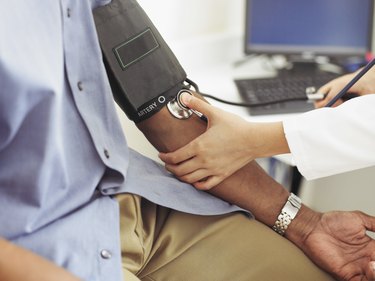
You've just been to the doctor, where, after the familiar Velcro rip of the pressure cuff leaving your bicep, you heard the words you'd been hoping to avoid: "Your systolic blood pressure is high."
If this sounds familiar, you're far from alone. Nearly one in two U.S. adults — 108 million people — have high blood pressure, reports the Center's for Disease Control and Prevention's Million Hearts website. Though common, high blood pressure (hypertension) is a serious condition that can put you at a greater risk for heart disease, stroke and kidney failure. However, lifestyle changes can be the first step to getting your blood pressure back within a healthy range.
Video of the Day
Video of the Day
"Lifestyle is extraordinarily important," says Jeffrey S. Berger, MD, a cardiologist and co-director of the Leon H. Charney Division of Cardiology at NYU Langone Health in New York City. "We have the ability to make significant changes that have very positive impacts without pharmacological therapy."
What is Systolic Blood Pressure?
When your doctor measures your blood pressure, you hear two numbers. The first is your systolic blood pressure, the amount of pressure that your heart exerts against the walls of your arteries with each pump. The second number, your diastolic blood pressure, is the pressure that your heart exerts between beats.
Many factors can push systolic blood pressure beyond normal, or above 120 millimeters of mercury, according to the American Heart Association. One factor is age. Over time, plaque can build up in the walls of your arteries, requiring the heart to exert more effort with each pump. But diet, weight, exercise habits and stress can exacerbate the problem.
Try Cutting Back on the Salt
Reducing your sodium intake can play an important role in lowering your systolic blood pressure. The average American consumes more than 3,500 milligrams of sodium daily, which is well above the American Heart Association's recommendation of less than 2,300 milligrams per day.
"I think we all know that adding salt to your food is bad for your blood pressure," Dr. Berger says. "But what we don't always know is that when you eat food from a can or a box, it is filled with sodium."
Dr. Berger recommends following a reduced-sodium diet called DASH (for Dietary Approaches to Stopping Hypertension), developed by the National Heart, Lung, and Blood Institute, which also emphasizes a reduction in trans fats and refined sugar, as well as a sufficient intake of magnesium, potassium and calcium.
Because everyone responds differently to dietary changes, it may take some fine-tuning to find the right diet for your specific heart health.
"Everyone's sodium responsiveness is a bit different," says Howard Weintraub, MD, the clinical director of the Center for the Prevention of Cardiovascular Disease, at NYU Langone Health in New York City. "So if you're going to take the time to modify your nutrition, you shouldn't only reduce how much salt you use, but also make it more healthy in general."
In other words, Dr. Weintraub says, leaving the salt off but continuing to eat French fries probably isn't going to help.
Get Moving and Shed a Few Pounds
"The more you exercise, the better off you will be, and your blood pressure will drop accordingly," says Dr. Berger.
You don't have to suddenly start training for a triathlon to see positive effects on your blood pressure. From jogging to cycling to Zumba classes, engaging in moderate-to-high intensity exercise for about 30 minutes five days a week can help.
In terms of lowering your systolic blood pressure through weight loss, Dr. Weintraub says that recommendations vary, depending on your baseline weight. But as a general rule of thumb, losing 8 percent of your body weight can have significant benefits.
Additional Ways to Lower Your Systolic Blood Pressure
Steering clear of cigarettes, keeping your alcohol consumption to a minimum and getting enough sleep can help lower your systolic blood pressure, too.
"It's also really important to know your numbers," Dr. Weintraub adds, explaining that, depending on specifics such as age, weight, gender and ethnicity, your risk factors for heart disease may vary. Engage in ongoing, transparent conversations with your doctor about your risk factors to help you stay on top of your blood pressure and ensure it stays within a healthy range.
- American Heart Association, “How much sodium should I eat per day?”
- American Heart Association, “The Facts About High Blood Pressure”
- American Heart Association, “Understanding Blood Pressure Readings”
- National Heart, Lung, and Blood Institute, “DASH Diet”
- Jeffrey S. Berger, MD, cardiologist, co-director, Leon H. Charney Division of Cardiology, NYU Langone Health, New York City
- Howard Weintraub, MD, preventive cardiologist, clinical director, NYU Langone Center for the Prevention of Cardiovascular Disease, New York.
- Center for Disease Control and Prevention, Million Hearts: "Estimated Hypertension Prevalence, Treatment and Control Among U.S. Adults"
Is this an emergency? If you are experiencing serious medical symptoms, please see the National Library of Medicine’s list of signs you need emergency medical attention or call 911.